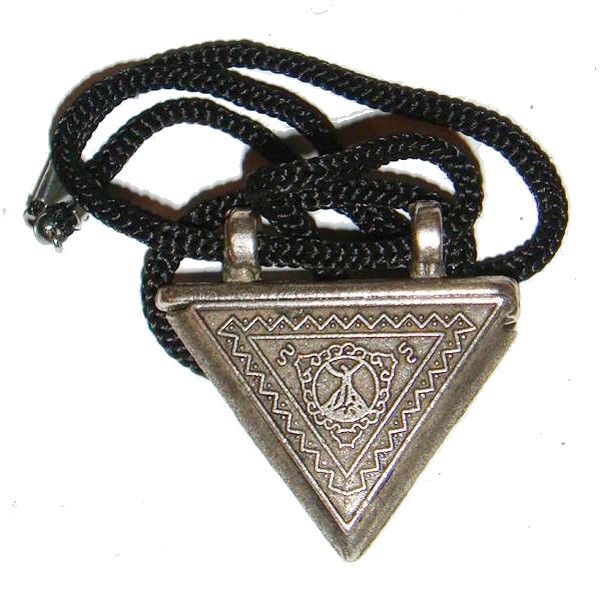Kazakh Evil Eye and Evil Spirit (Assel Uvaliyeva)
Title: Kazakh Evil Eye and Evil Spirit
General Information about Item:
- Customary Folklore: Kazakh Supersition – Evil Eye and Evil Spirits
- Language: English
- Country of Origin: Kazakhstan
- Informant: Assel Uvaliyeva
- Date Collected: May 24, 2019
Informant Data:
- Assel is a graduate student from Almaty, Kazakhstan. She works as a teacher’s assistant and studies comparitive literature. Assel speaks Kazahk, Russian, French, and English.
Contextual Data:
- Cultural Context: Evil eye superstitions have been informed by the various Russian and Arab/Muslim influences on the Steppe. Some aspects of the superstition pre-date foreign influences, such as ‘tumar.’ Despite disparate influences, the evil eye superstition has formed an identity of its own. Kazakhs employ a variety of methods, such as the use of a horseshoe on a door or the recitation of a saying, in order to ward off the evil.
- Social Context: The informant was interviewed twice in-person. The first interview gave an account of the historical context of the evil eye in Kazakhstan, while the second provided Russian examples that are used for evil spirits.
Text and Texture:
- Tumar
тұмар
Tumar
too-mar
Amulet
Bracelet to protect against evil eye
- Shaitan
Шайтан
Shaitan
Shy-tan
Devil
- Köz
көз
Köz
Kouyz
Eye
- Glas
глаз
Glas
Glahss (like ‘Glass’ but the ‘G’ is prounced “Guh” and the ‘a’ is prounced ‘ah’)
Eye
- Podkova
подкова
Podkova
pod-koh-vah
Horseshoe
(Used contextually by the informant as an item of material folklore to protect against evil)
- Russian Saying
туш туш туш так не глазить
tush tush tush tak ne glazit
Tisk tisk tisk so not to look
Tisk tisk tisk don’t stare
(туш does not have any specific meaning but is just a sound. The useage of ’tisk’ is meant to convey a phonetically similar sound, since there does not seem to exist an English equivalent.)
Item:
The existence of evil spirits and the evil eye has been developed throughout Kazakh history. ‘Tumar,’ an item worn to prevent evil, pre-dates external influences but has since taken on new dimensions with Islamic influence. Evil spirits are thought to exist, and the people generally identify the incursion of evil with the symbol of an eye.
Tumar:

(Source: http://aboutkazakhstan.com/about-kazakhstan-national-features)
Audio File:
Assel Uvaliyeva – Kazakh Evil Eye – Interview 1
Assel Uvaliyeva – Kazakh Evil Eye – Interview 2
Transcript:
Interview 1:
A: Assel
L: Alex Leibowitz
S: Saif Malley
S: So yes, if you can just start with, like, your name and where you’re from.
A: My name is Assel Uvaliyeva. I’m from Kazakhstan.
A: Yes. But first I probably need to give you a context. I think in Kazakhstan we have strong Arabic Muslim influences and also Russian and actually many inter-cultural influences, but definitely Islam and Russian traditions. And some for the evil spirits, I’m not sure. I think it’s hard to trace the origin, but, for example, we do have the evil eye and, and it’s interesting like for… to protect like yourself from the evil spirits you wear ‘tumar.’ It can be made of silver or leather and it’s actually a shamanic tradition that existed before like Arabic or Russian invasion. And… and so inside you now people put a prayer or like Surah from Quran or something like that to protect themselves from evil spirits and then, and so I think it’s an example of the syncretic tradition and then will tell us the evil spirit, the main evil spirit, is called ‘Shaitan,’ but it’s also exist in the Arab world. Also like after the Arabs came to the steppe. We also have the influence like of different, not Arabs, but different Muslims. And for example, we have the influence of birth traditions and like jeans. I mean, I can talk about it a lot more. I just don’t know how much information do you need.
L: That’s really good. Yeah. Thanks. Appreciate it.
S: Thank you.
Interview 2:
A: For example, I think you talked about ‘international forms’ (unclear audio) of good luck. I think Kazakhs exported from Russian, but like in order to not to jinx someone you knock on wood but it’s probably universal, right? And like Russians say to ‘toosh toosh toosh’ that new glasses and safety to Christian jessen, and in Kazakh version, it’s like, köz, the eye, like doesn’t touch like this person cause… eye, in Russian too its “glaz.’ It’s actually has like the eye, so I think the image the symbol of the eyes is universal. In Russian you also have a horse. I’m not sure what it’s called in English. (To a nearby person) A: ‘Steven, what is “podkova?” Steven: Like a horseshoe? (Return to interview) A: Yeah, like a horseshoe. So they put on… oh, we saw it in Viy (Russian horror film based on Gogol’s Viy), I think, on the door and we don’t and so to prevent the evil spirits from entering the house, for example.
L: Thanks so much.
Informant’s Comments:
“I think the image the symbol of the eyes is universal.”
(Stated within the context of evil spirits and evil eye superstitions).
Collector’s Comments:
Kazakhstan has served as an intermediary in historical trading routes. The influence of a variety of cultures has led to an aggregated evil eye belief. This belief ultimately reflects the presence of evil spirits, and the actions an individual must take when they are encountered.
Collector’s Name: Saif Malley & Alex Leibowitz
Tags/Keywords:
- Customary Folklore
- Kazakh Superstition
- Russian Superstition
- Evil Eye
- Tumar
